Determining Spatial Responses of Fishers (Pekania Pennanti) to Mechanical Treatments of Forest Stands for Fuel Reduction
Simple Summary
Abstract
1. Introduction
2. Materials and Methods
2.1. Study Area
2.2. Capture, Handling, and Monitoring
2.3. Home Range Estimates and ArcGIS Analysis
2.4. Statistical Analyses
3. Results
3.1. Capture and Monitoring
3.2. Home Ranges and Treatment Units
3.3. Treatment Responses
4. Discussion
5. Conclusions
Author Contributions
Funding
Institutional Review Board Statement
Data Availability Statement
Acknowledgments
Conflicts of Interest
References
- Powell, R.A.; Zielinski, W.J. The Fisher. In The Scientific Basis for Conserving Forest Carnivores: American Marten, Fisher, Lynx, and Wolverine in the Western United States; Ruggiero, L.F., Aubry, K.B., Buskirk, S.W., Lyon, L.J., Zielinski, W.J., Eds.; General Technical Report GTR RM-254; U.S. Department of Agriculture, Forest Service, Rocky Mountain Forest and Range Experiment Station: Fort Collins, CO, USA, 1994; pp. 38–73. [Google Scholar]
- Zielinski, W.J.; Truex, R.L.; Schmidt, G.A.; Schlexer, F.V.; Schmidt, K.N.; Barrett, R.H. Resting Habitat Selection by Fishers in California. J. Wildl. Manag. 2004, 68, 475–492. [Google Scholar] [CrossRef]
- Thompson, C.M.; Zielinski, W.J.; Purcell, K.L. Evaluating Management Risks Using Landscape Trajectory Analysis: A Case Study of California Fisher. J. Wildl. Manag. 2011, 75, 1164–1176. [Google Scholar] [CrossRef]
- Buskirk, S.W.; Powell, R.A. Habitat Ecology of Fisher and American Martens. In Martens, Sables, and Fishers: Biology and Conservation; Buskirk, S.W., Harestad, A.S., Raphael, M.G., Powell, R.A., Eds.; Cornell University Press: Ithaca, NY, USA, 1994; pp. 283–296. [Google Scholar]
- Davis, F.W.; Seo, C.; Zielinski, W.J. Regional Variation in Home-range-scale Habitat Models for Fisher (Martes pennanti) in California. Ecol. Appl. 2007, 17, 2195–2213. [Google Scholar] [CrossRef] [PubMed]
- Lofroth, E.C.; Raley, C.M.; Higley, J.M.; Truex, R.L.; Yaeger, J.S.; Lewis, J.C.; Happe, P.J. Conservation of Fishers (Martes pennanti) in South-Central British Columbia, Western Washington, Western Oregon, and California—Volume I: Conservation Assessment; U.S. Department of the Interior, Bureau of Land Management: Denver, CO, USA, 2010.
- Aubry, K.B.; Raley, C.M.; Buskirk, S.W.; Zielinski, W.J.; Schwartz, M.K.; Golightly, R.T.; Purcell, K.L.; Weir, R.D.; Yaeger, J.S. Meta-analyses of Habitat Selection by Fishers at Resting Sites in the Pacific Coastal Region. J. Wildl. Manag. 2013, 77, 965–974. [Google Scholar] [CrossRef]
- Purcell, K.L.; Mazzoni, A.K.; Mori, S.R.; Boroski, B.B. Resting Structures and Resting Habitat of Fishers in the Southern Sierra Nevada, California. For. Ecol. Manag. 2009, 258, 2696–2706. [Google Scholar] [CrossRef]
- Green, R.E. Reproductive Ecology of the Fisher (Pekania pennanti) in the Southern Sierra Nevada: An Assessment of Reproductive Parameters and Forest Habitat Used by Denning Females. Ph.D. Dissertation, University of California, Davis, CA, USA, 2017. [Google Scholar]
- Thompson, C.M.; Purcell, K.L. Conditions Inside Fisher Dens During Prescribed Fires; What is the Risk Posed by Spring Underburns? For. Ecol. Manag. 2015, 359, 156–161. [Google Scholar] [CrossRef]
- Powell, R.A. The Fisher, 2nd ed.; University of Minnesota Press: Minneapolis, MN, USA, 1993. [Google Scholar]
- Gibilisco, C.J. Distributional Dynamics of Modern Martes in North America. In Martens, Sables, and Fishers: Biology and Conservation; Buskirk, S.W., Harestad, A.S., Raphael, M.G., Powell, R.A., Eds.; Cornell University Press: Ithaca, NY, USA, 1994; pp. 59–71. [Google Scholar]
- Aubry, K.B.; Lewis, J.C. Extirpation and Reintroduction of Fishers (Martes pennanti) in Oregon: Implications for their Conservation in the Pacific States. Biol. Conserv. 2003, 114, 79–90. [Google Scholar] [CrossRef]
- Zielinski, W.J.; Baldwin, J.A.; Truex, R.L.; Tucker, J.M.; Flebbe, P.A. Estimating Trend in Occupancy for the Southern Sierra Fisher Martes pennanti Population. J. Fish Wildl. Manag. 2013, 4, 3–19. [Google Scholar] [CrossRef]
- Lewis, J.C.; Zielinski, W.J. Historical Harvest and Incidental Capture of Fishers in California. Northwest Sci. 1996, 70, 291–297. [Google Scholar]
- Lacy, R.C. Importance of Genetic Variation to the Viability of Mammalian Populations. J. Mammal. 1997, 78, 320–335. [Google Scholar] [CrossRef]
- Wisely, S.M.; Buskirk, S.W.; Russell, G.A.; Aubry, K.B.; Zielinski, W.J. Genetic Diversity and Structure of the Fisher (Martes pennanti) in a Peninsular and Peripheral Metapopulation. J. Mammal. 2004, 85, 640–648. [Google Scholar] [CrossRef]
- Zielinski, W.J.; Thompson, C.M.; Purcell, K.L.; Garner, J.D. An Assessment of Fisher (Pekania pennanti) Tolerance to Forest Management Intensity on the Landscape. For. Ecol. Manag. 2013, 310, 821–826. [Google Scholar] [CrossRef]
- Hessburg, P.F.; Agee, J.K.; Franklin, J.F. Dry Forests and Wildland Fires of the Inland Northwest USA: Contrasting the Landscape Ecology of the Pre-settlement and Modern Eras. For. Ecol. Manag. 2005, 211, 117–139. [Google Scholar] [CrossRef]
- Raymond, C.L.; Peterson, D.L. Fuel Treatments Alter the Effects of Wildfire in a Mixed-evergreen Forest, Oregon, USA. Can. J. For. Res. 2005, 35, 2981–2995. [Google Scholar] [CrossRef]
- McIver, J.D.; Stephens, S.L.; Agee, J.K.; Barbour, J.; Boerner, R.E.J.; Edminster, C.B.; Erickson, K.L.; Farris, K.L.; Fettig, C.J.; Fiedler, C.E.; et al. Ecological Effects of Alternative Fuel-reduction Treatments: Highlights of the National Fire and Fire Surrogate Study (FFS). Int. J. Wildland Fire 2013, 22, 63–82. [Google Scholar] [CrossRef]
- Kalies, E.L.; Yocom Kent, L.L. Tamm Review: Are Fuel Treatments Effective at Achieving Ecological and Social Objectives? A Systematic Review. For. Ecol. Manag. 2016, 375, 84–95. [Google Scholar] [CrossRef]
- Fisher, J.T.; Wilkinson, L. The Response of Mammals to Forest Fire and Timber Harvest in the North American Boreal Forest. Mammal Rev. 2005, 35, 51–81. [Google Scholar] [CrossRef]
- Sweitzer, R.A.; Furnas, B.J.; Barrett, R.H.; Purcell, K.L.; Thompson, C.M. Landscape Fuel Reduction, Forest Fire, and Biophysical Linkages to Local Habitat Use and Local Persistence of Fishers (Pekania pennanti) in Sierra Nevada Mixed-conifer Forests. For. Ecol. Manag. 2016, 361, 208–225. [Google Scholar] [CrossRef]
- Truex, R.L.; Zielinski, W.J. Short-term Effects of Fuel Treatments on Fisher Habitat in the Sierra Nevada, California. For. Ecol. Manag. 2013, 293, 85–91. [Google Scholar] [CrossRef]
- Scheller, R.M.; Spencer, W.D.; Rustigian-Romsos, H.; Syphard, A.D.; Ward, B.C.; Strittholt, J.R. Using Stochastic Simulation to Evaluate Competing Risks of Wildfires and Fuels Management on an Isolated Forest Carnivore. Landsc. Ecol. 2011, 26, 1491–1504. [Google Scholar] [CrossRef]
- Zielinski, W.J.; Dunk, J.R.; Gray, A.N. Estimating Habitat Value Using Forest Inventory Data: The fisher (Martes pennanti) in Northwestern California. For. Ecol. Manag. 2012, 275, 35–42. [Google Scholar] [CrossRef]
- Agee, J.K.; Skinner, C.N. Basic Principles of Forest Fuel Reduction Treatments. For. Ecol. Manag. 2005, 211, 83–96. [Google Scholar] [CrossRef]
- Olson, L.E.; Sauder, J.D.; Albrecht, N.M.; Vinkey, R.S.; Cushman, S.A.; Schwartz, M.K. Modeling the Effects of Dispersal and Patch Size on Predicted Fisher (Pekania [Martes] pennanti) Distribution in the U.S. Rocky Mountains. Biol. Conserv. 2014, 169, 89–98. [Google Scholar] [CrossRef]
- Agee, J.K. Fire Ecology of Pacific Northwest Forests; Island Press: Washington, DC, USA, 1993. [Google Scholar]
- U.S. Forest Service. Ashland Forest Resiliency Draft Environmental Impact Statement; U.S. Forest Service, Rogue River-Siskiyou National Forest: Medford, OR, USA, 2005.
- Wilbert, J.C. Spatial Scale and Seasonality of Habitat Selection by Martens in Southeastern Wyoming. Master’s thesis, University of Wyoming, Laramie, WY, USA, 1992. [Google Scholar]
- Seglund, A.E. The Use of Resting Sites by the Pacific Fisher. Master’s thesis, Humboldt State University, Arcata, CA, USA, 1995. [Google Scholar]
- Sikes, R.S.; Gannon, W.L.; The Animal Care and Use Committee of the American Society of Mammalogists. Guidelines of the American Society of Mammalogists for the Use of Wild Mammals in Research. J. Mammal. 2011, 92, 235–253. [Google Scholar] [CrossRef]
- Sauder, J.D.; Rachlow, J.L. Both Forest Composition and Configuration Influence Landscape-scale Habitat Selection by Fishers (Pekania pennanti) in Mixed Coniferous Forests of the Northern Rocky Mountains. For. Ecol. Manag. 2014, 314, 75–84. [Google Scholar] [CrossRef]
- Dussault, C.; Réhaume, C.; Ouellet, J.; Pettorelli, J. Influence of Satellite Geometry and Differential Correction on GPS Location Accuracy. Wildl. Soc. Bull. 2001, 29, 171–179. [Google Scholar]
- Lewis, J.S.; Rachlow, J.L.; Garton, E.O.; Vierling, L.A. Effects of Habitat on GPS Collar Performance: Using Data Screening to Reduce Location Error. J. Appl. Ecol. 2007, 44, 663–671. [Google Scholar] [CrossRef]
- Recio, M.R.; Mathieu, R.; Denys, P.; Surguey, P.; Seddon, P.J. Lightweight GPS-tags, One Giant Leap for Wildlife Tracking? An Assessment Approach. PLoS ONE 2011, 6, e28225. [Google Scholar] [CrossRef]
- Odum, E.P.; Kuenzler, E.J. Measurement of territory and home range size in birds. Auk 1955, 72, 128–137. [Google Scholar] [CrossRef]
- Levene, H. Robust Tests for Equality of Variances. In Contributions to Probability and Statistics: Essays in Honor of Harold Hotelling; Olkin, I., Ed.; Stanford University Press: Palo Alto, CA, USA, 1960; pp. 278–292. [Google Scholar]
- Sullivan, G.M.; Feinn, R. Using Effect Size—Or Why the P Value is Not Enough. J. Grad. Med. Educ. 2012, 4, 279–282. [Google Scholar] [CrossRef]
- Smirnov, N.V. Estimate of Deviation Between Empirical Distribution Functions in Two Independent Samples. Bull. Mosc. Univ. 1939, 2, 3–16. [Google Scholar]
- McCune, B.; Grace, J.B.; Urban, D.L. MRPP (Multi-response Permutation Procedures) and Related Techniques. In Analysis of Ecological Communities; McCune, B., Grace, J.B., Eds.; MjM Software Design: Gleneden, OR, USA, 2002; pp. 188–197. [Google Scholar]
- Cai, L. Multi-response Permutation Procedure as an Alternative to the Analysis of Variance: An SPSS Implementation. Behav. Res. Methods 2006, 38, 51–59. [Google Scholar] [CrossRef] [PubMed]
- U.S. Department of Agriculture. Ashland Forest Resiliency Final Environmental Impact Statement; U.S. Forest Service, Rogue River-Siskiyou National Forest: Jackson County, OR, USA, 2008.
- Garner, J.D. Selection of Disturbed Habitat by Fishers (Martes pennanti) in the Sierra National Forest. Master’s thesis, Humboldt State University, Arcata, CA, USA, 2013. [Google Scholar]
- McHugh, M.L. The Chi-square Test of Independence. Biochem. Medica 2013, 23, 143–149. [Google Scholar] [CrossRef] [PubMed]
- Cohen, J. A Power Primer. Psychol. Bull. 1992, 112, 155–159. [Google Scholar] [CrossRef] [PubMed]
- R Development Core Team. R: A Language and Environment for Statistical Computing, Version 3.4.3.; R Foundation for Statistical Computing: Vienna, Austria, 2017. Available online: https://www.R-project.org. (accessed on 16 April 2024).
- R Development Core Team. R: A Language and Environment for Statistical Computing, Version 2.6.2.; R Foundation for Statistical Computing: Vienna, Austria, 2008. Available online: https://www.R-project.org. (accessed on 23 April 2024).
- Amaral, K.E.; Palace, M.; O’Brien, K.M.; Fenderson, L.E.; Kovach, A.I. Anthropogenic Habitats Facilitate Dispersal of an Early Successional Obligate: Implications for Restoration of an Endangered Ecosystem. PLoS ONE 2016, 11, e0148842. [Google Scholar] [CrossRef]
- Moriarty, K.M.; Epps, C.W.; Zielinski, W.J. Forest Thinning Changes Movement Patterns and Habitat Use by Pacific Marten. J. Wildl. Manag. 2016, 80, 621–633. [Google Scholar] [CrossRef]
- Tempel, D.J.; Gutierrez, R.J.; Whitmore, S.A.; Reetz, M.J.; Stoelting, R.E.; Berigan, W.J.; Seamans, M.E.; Peery, M.Z. Effects of Forest Management on California Spotted Owls: Implications for Reducing Wildfire Risk in Fire-prone Forests. Ecol. Appl. 2014, 24, 2089–2106. [Google Scholar] [CrossRef]
- Zielinski, W.J.; Truex, R.L.; Schlexer, F.V.; Campbell, L.A.; Carroll, C. Historical and Contemporary Distributions of Carnivores in Forests of the Sierra Nevada, California, USA. J. Biogeogr. 2005, 32, 1385–1407. [Google Scholar] [CrossRef]
- Lesmerises, F.; Dussault, C.; St-Laurent, M.H. Wolf Habitat Selection is Shaped by Human Activities in a Highly Managed Boreal Forest. For. Ecol. Manag. 2012, 276, 125–131. [Google Scholar] [CrossRef]
- Hebblewhite, M.; Munro, R.; Merrill, E. Trophic Consequences of Post-fire Logging in a Wolf-elk System. For. Ecol. Manag. 2009, 257, 1053–1062. [Google Scholar] [CrossRef]
- Krebs, J.; Lofroth, E.C.; Parfitt, I. Multiscale Habitat Use by Wolverines in British Columbia, Canada. J. Wildl. Manag. 2007, 71, 2180–2192. [Google Scholar] [CrossRef]
- Fisher, J.T.; Bradbury, S.; Anholt, B.; Nolan, L.; Roy, L.; Volpe, J.P.; Wheatley, M. Wolverines (Gulo gulo luscus) on the Rocky Mountain Slopes: Natural Heterogeneity and Landscape Alteration as Predictors of Distribution. Can. J. Zool. 2013, 91, 706–716. [Google Scholar] [CrossRef]
- Scrafford, M.A.; Avgar Abercrombie, T.B.; Tigner, J.; Boyce, M.S. Wolverine Habitat Selection in Response to Anthropogenic Disturbance in the Western Canadian Boreal Forest. For. Ecol. Manag. 2017, 395, 27–36. [Google Scholar] [CrossRef]
- Martin, J.G.; Réale, D. Temperament, Risk Assessment and Habituation to Novelty in Eastern Chipmunks, Tamias striatus. Anim. Behav. 2008, 75, 309–318. [Google Scholar] [CrossRef]
- Beale, C.M. The Behavioral Ecology of Disturbance Responses. Int. J. Comp. Psych. 2007, 20, 111–120. [Google Scholar] [CrossRef]
- Tucker, J.M.; Allendorf, F.W.; Truex, R.L.; Schwartz, M.K. Sex-biased Dispersal and Spatial Heterogeneity Affect Landscape Resistance to Gene Flow in Fisher. Ecosphere 2017, 8, e01839. [Google Scholar] [CrossRef]
- Lewis, J.C.; Happe, P.J.; Jenkins, K.J.; Manson, D.J. Factors Influencing the Postrelease Movements of Translocated Fishers: Implications for Translocation Success. J. Fish Wildl. Manag. 2022, 13, 50–67. [Google Scholar] [CrossRef]
- Niblett, M.R.; Sweeney, S.H.; Church, R.L.; Barber, K.H. Structure of Fisher (Pekania pennanti) Habitat in a Managed Forest in an Interior Northern California Coast Range. For. Sci. 2015, 61, 481–493. [Google Scholar] [CrossRef]
- Raley, C.M.; Lofroth, E.C.; Truex, R.L.; Yaeger, J.S.; Higley, J.M. Habitat Ecology of Fishers in Western North America: A New Synthesis. In Biology and Conservation of Martens, Sables, and Fishers: A New Synthesis; Aubry, K.B., Zielinski, W.J., Raphael, M.G., Proulx, G., Buskirk, S.W., Eds.; Cornell University Press: Ithaca, NY, USA, 2012; pp. 231–254. [Google Scholar]
- Frair, J.L.; Nielsen, S.E.; Merrill, E.H.; Lele, S.R.; Boyce, M.S.; Munro, R.H.M.; Stenhouse, G.B.; Beyer, H.L. Removing GPS Collar Bias in Habitat Selection Studies. J. Appl. Ecol. 2004, 41, 201–212. [Google Scholar] [CrossRef]
- Cain, J.W.; Krausman, P.R.; Jansen, B.D.; Morgart, J.R. Influence of Topography and GPS Fix Interval on GPS Collar Performance. Wildl. Soc. Bull. 2005, 33, 926–934. [Google Scholar] [CrossRef]
- U.S. Department of Agriculture. Final Environmental Impact Statement: Beaverside Timber Sale and Fuel Treatment Project; U.S. Forest Service, Six Rivers National Forest: Trinity County, CA, USA, 2009.
- Weir, R.D.; Phinney, M.; Lofroth, E.C. Big, Sick, and Rotting: Why Tree Size, Damage, and Decay are Important to Fisher Reproductive Habitat. For. Ecol. Manag. 2012, 265, 230–240. [Google Scholar] [CrossRef]
- Odion, D.C.; Frost, E.J.; Strittholt, J.R.; Jiang, H.; DellaSala, D.A.; Moritz, M.A. Patterns of Fire Severity and Forest Conditions in the Western Klamath Mountains, California. Conserv. Biol. 2004, 18, 927–936. [Google Scholar] [CrossRef]
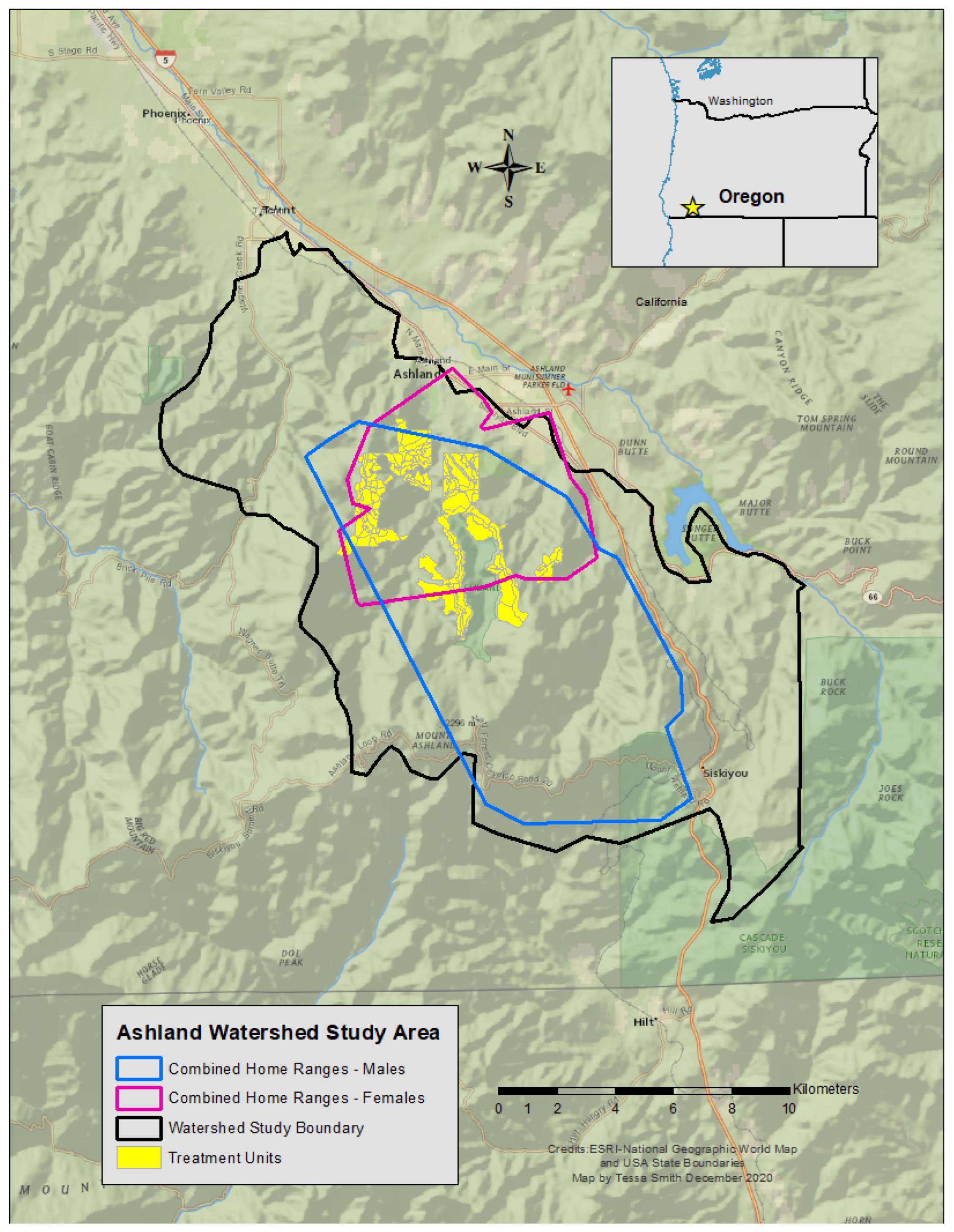
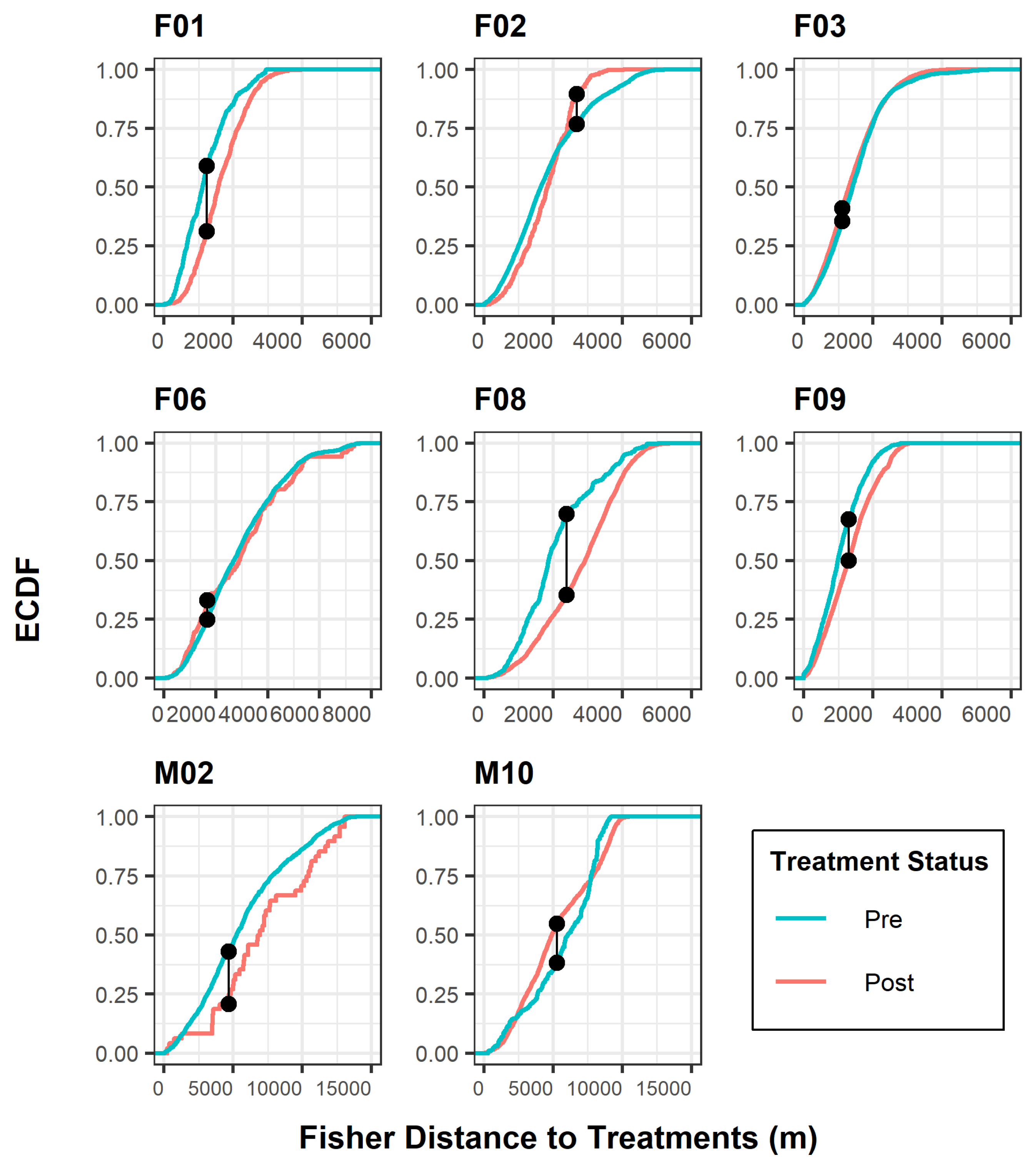
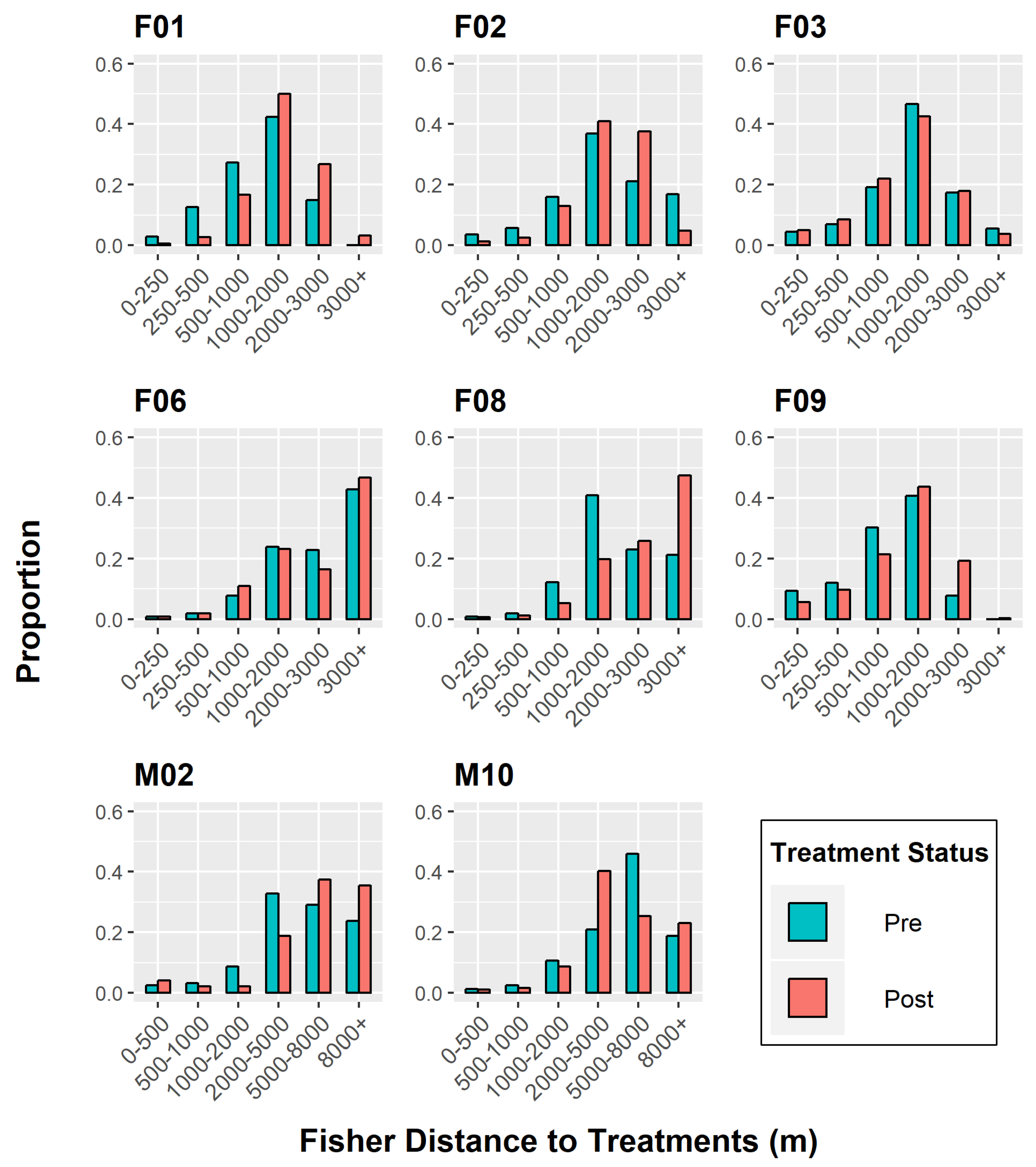
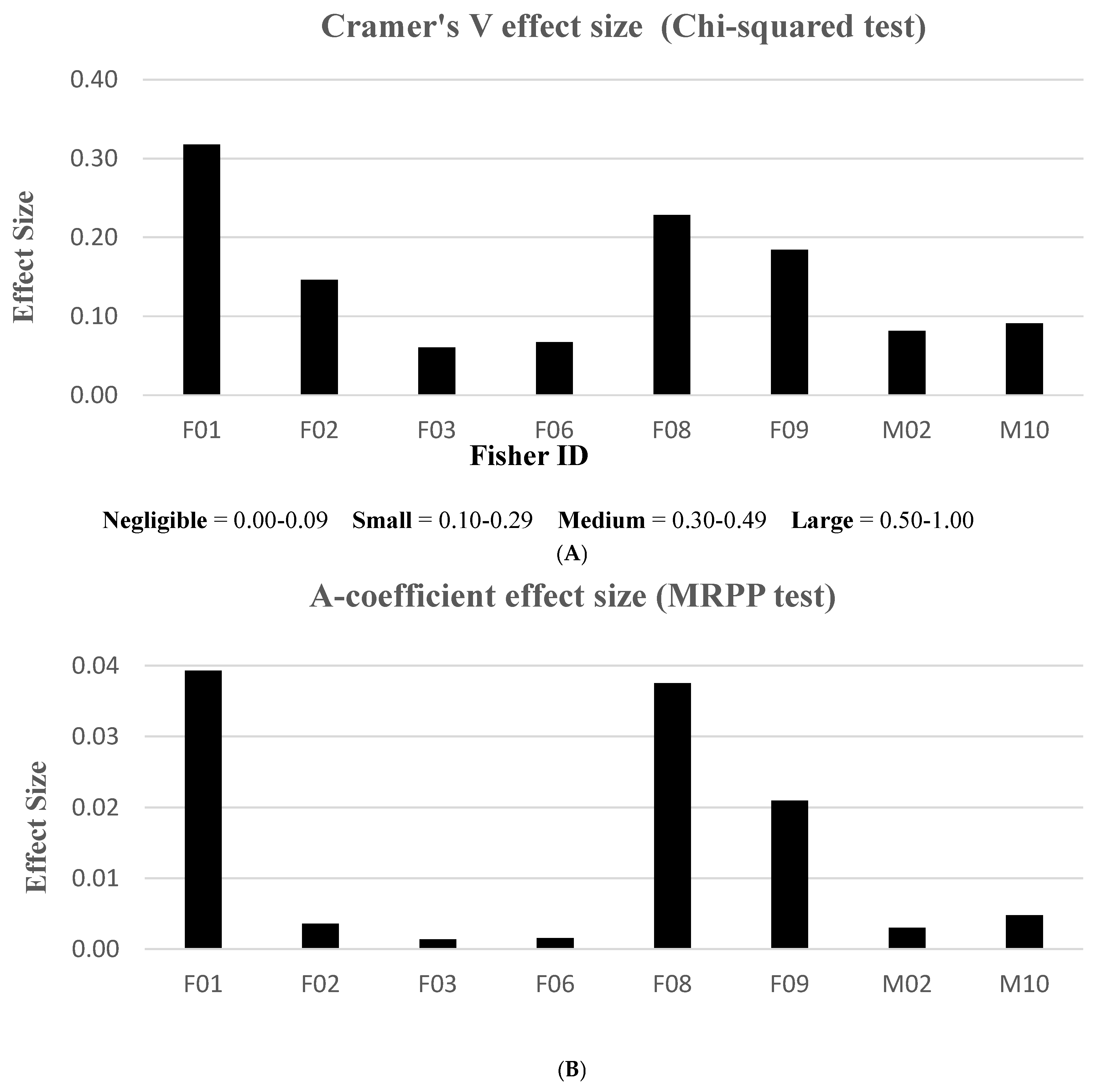
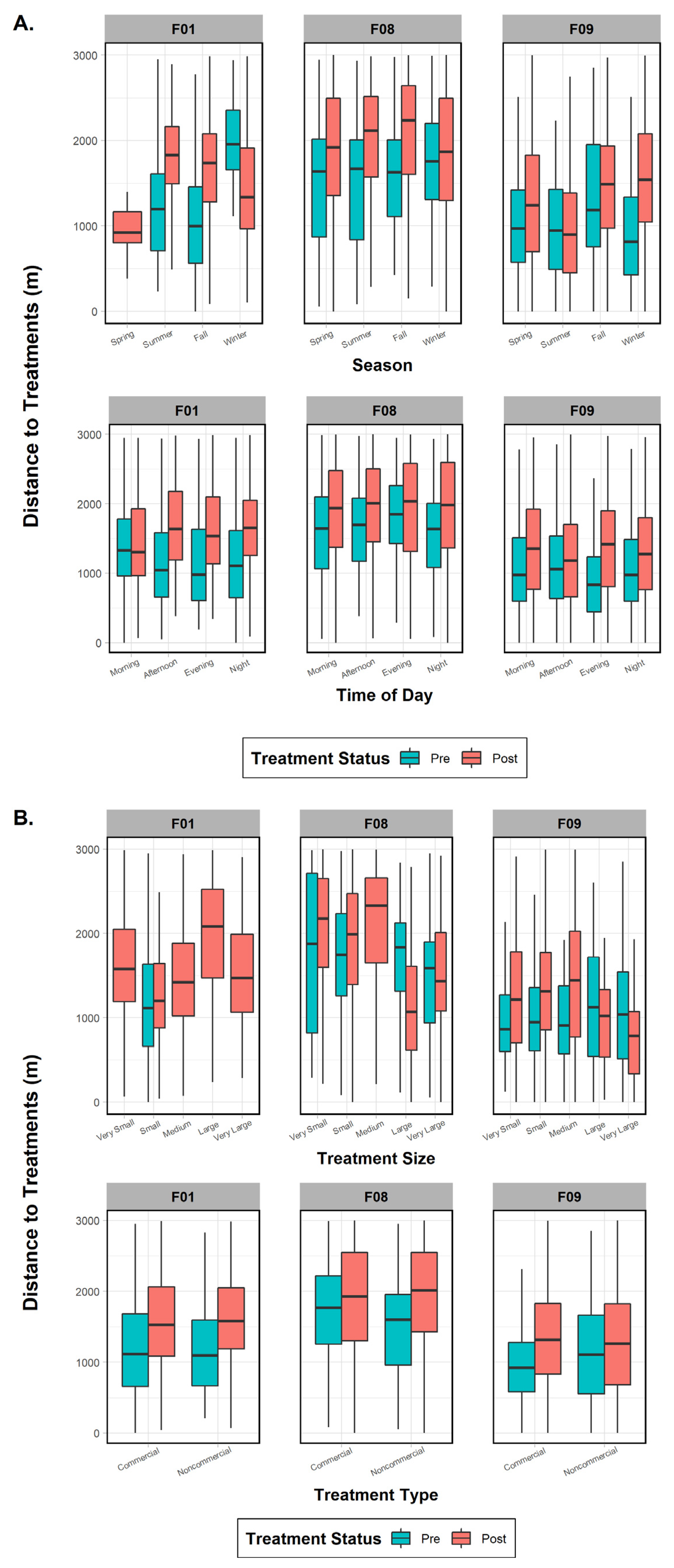
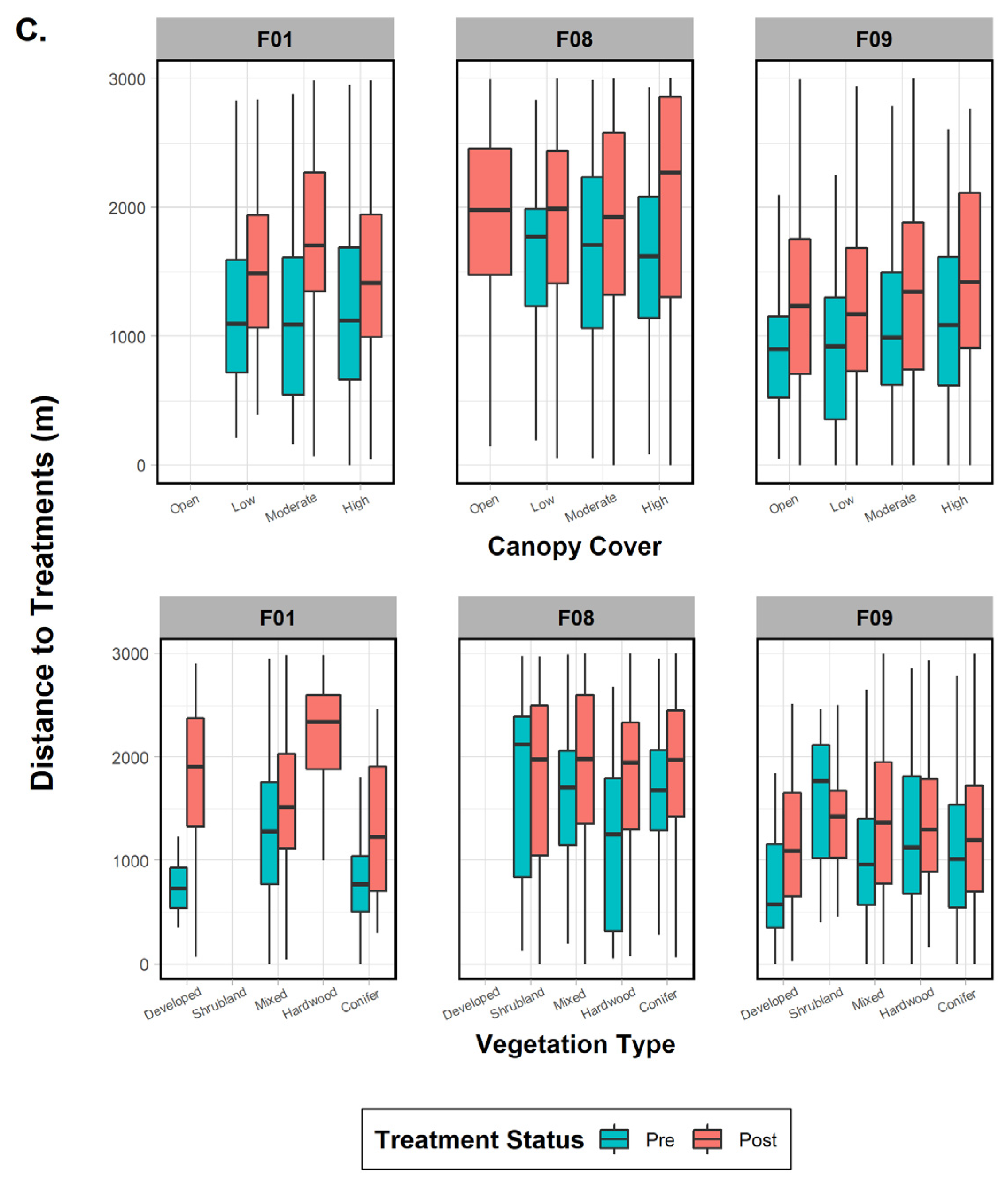
| Fisher ID | Locations | Acquisition Rate (%) | Days Monitored | Years Monitored |
|---|---|---|---|---|
| F01 | 213 | 31 | 148 | 2010–2014, 2016 |
| F02 | 90 | 24 | 67 | 2010–2011 |
| F03 | 360 | 26 | 258 | 2011–2017 |
| F04 | 43 | 24 | 32 | 2010–2011 |
| F06 | 82 | 68 | 56 | 2011–2012 |
| F08 | 123 | 25 | 80 | 2012–2014, 2017 |
| F09 | 263 | 50 | 167 | 2012–2013 |
| M02 | 24 | 13 | 22 | 2010 |
| M04 | 70 | 34 | 55 | 2014 |
| M10 | 84 | 60 | 40 | 2014 |
| Total | 1352 | 32 | 925 | 7 years |
| Fisher ID | Home-Range Size (km2) | # of Treated Units in Home Range | Size of All Treated Units (ha) | Proportion of the Size of All Treated Units to Home Range Size | # of Mechanically Treated Units in Home Range | Size of Mechanically Treated Units (ha) | Proportion of Mechanically Treated Units to Home Range |
|---|---|---|---|---|---|---|---|
| F01 | 9.81 | 11 | 96 | 0.10 | 8 | 76 | 0.08 |
| F02 | 14.99 | 85 | 696 | 0.46 | 50 | 429 | 0.29 |
| F03 | 13.89 | 70 | 478 | 0.34 | 39 | 316 | 0.23 |
| F04 | 20.69 | 73 | 834 | 0.40 | 47 | 464 | 0.22 |
| F06 | 34.14 | 81 | 978 | 0.29 | 54 | 597 | 0.18 |
| F08 | 12.40 | 61 | 553 | 0.45 | 46 | 378 | 0.31 |
| F09 | 7.99 | 40 | 431 | 0.54 | 29 | 272 | 0.34 |
| M02 | 65.42 | 86 | 1025 | 0.16 | 60 | 643 | 0.10 |
| M04 | 102.23 | 136 | 1369 | 0.13 | 83 | 853 | 0.08 |
| M10 | 40.23 | 76 | 993 | 0.25 | 48 | 606 | 0.15 |
| Average | 32.18 | 72 | 745 | 46 | 463 |
| Treatment Type | No. of Units | Area Size (ha) | Area Mean (ha) | Proportion of Treatment to Managed Area | Proportion of Treatment to Watershed Area a |
|---|---|---|---|---|---|
| Commercial b | 59 | 498 | 8.44 ± 7.22 | 0.362 | 0.0199 |
| Noncommercial b | 63 | 640 | 10.15 ± 11.49 | 0.465 | 0.0256 |
| Burn only c | 9 | 185 | 20.61 ± 22.50 | 0.134 | 0.0074 |
| Untreated d | 7 | 53 | 7.62 ± 3.46 | 0.039 | 0.0021 |
| Total | 138 | 1376 | -- | 1 | 0.0551 |
| MRPP | KS | Chi-Square Test | |||||||
|---|---|---|---|---|---|---|---|---|---|
| Fisher ID | Delta | A | p | D | p | χ2 | df | p | |
| F01 | Pre | 782 | 0.039 | <0.001 | 0.280 | <0.001 | 187.69 | 7 | <0.001 |
| Post | 807 | ||||||||
| F02 | Pre | 1265 | 0.004 | <0.001 | 0.127 | <0.001 | 129.59 | 7 | <0.001 |
| Post | 847 | ||||||||
| F03 | Pre | 940 | 0.001 | <0.001 | 0.056 | <0.001 | 78.49 | 7 | <0.001 |
| Post | 904 | ||||||||
| F06 | Pre | 1752 | 0.002 | <0.001 | 0.083 | 0.004 | 21.98 | 7 | 0.003 |
| Post | 2041 | ||||||||
| F08 | Pre | 1175 | 0.038 | <0.001 | 0.344 | <0.001 | 303.04 | 7 | <0.001 |
| Post | 1302 | ||||||||
| F09 | Pre | 672 | 0.021 | <0.001 | 0.176 | <0.001 | 238.70 | 7 | <0.001 |
| Post | 827 | ||||||||
| M02 | Pre | 3711 | 0.003 | <0.001 | 0.221 | 0.021 | 10.56 | 7 | 0.159 |
| Post | 4069 | ||||||||
| M10 | Pre | 504 | 0.004 | <0.001 | 0.167 | <0.001 | 41.95 | 7 | <0.001 |
| Post | 4704 | ||||||||
| (A) | |||||
|---|---|---|---|---|---|
| Pre-Treatment Variable | df | Sum of Squares | Mean Squares | F | p |
| Season | 3 | 5.17 × 107 | 17,241,944 | 41.2387 | <0.001 |
| Time of day | 3 | 4.00 × 106 | 1,332,588 | 3.1872 | 0.023 |
| Treatment type | 1 | 8.06 × 106 | 80,645,488 | 19.2886 | <0.001 |
| Vegetation class | 4 | 2.59 × 107 | 6,484,672 | 15.5098 | <0.001 |
| Treatment size | 4 | 5.76 × 106 | 1,439,561 | 3.4431 | <0.001 |
| Canopy cover | 3 | 2.14 × 107 | 7,121,796 | 17.0337 | <0.001 |
| Error | 3536 | 1.48 × 109 | 418,101 | ||
| (B) | |||||
| Post-Treatment Variable | df | Sum of Squares | Mean Squares | F | p |
| Season | 3 | 2.56 × 108 | 85,197,703 | 161.9846 | <0.001 |
| Time of day | 3 | 2.16 × 106 | 720,643 | 1.3701 | 0.250 |
| Treatment type | 1 | 6.80 × 105 | 679,606 | 1.2921 | 0.256 |
| Vegetation class | 4 | 7.63 × 107 | 19,067,905 | 36.2534 | <0.001 |
| Treatment size | 4 | 1.06 × 108 | 26,457,317 | 50.3027 | <0.001 |
| Canopy cover | 3 | 4.25 × 106 | 1,416,785 | 2.6937 | 0.004 |
| Error | 3536 | 4.41 × 109 | 525,962 |
Disclaimer/Publisher’s Note: The statements, opinions and data contained in all publications are solely those of the individual author(s) and contributor(s) and not of MDPI and/or the editor(s). MDPI and/or the editor(s) disclaim responsibility for any injury to people or property resulting from any ideas, methods, instructions or products referred to in the content. |
© 2025 by the authors. Licensee MDPI, Basel, Switzerland. This article is an open access article distributed under the terms and conditions of the Creative Commons Attribution (CC BY) license (https://creativecommons.org/licenses/by/4.0/).
Share and Cite
Smith, T.R.; Gese, E.M.; Clayton, R.D.; Terletzky, P.A.; Purcell, K.L.; Thompson, C.M. Determining Spatial Responses of Fishers (Pekania Pennanti) to Mechanical Treatments of Forest Stands for Fuel Reduction. Animals 2025, 15, 434. https://doi.org/10.3390/ani15030434
Smith TR, Gese EM, Clayton RD, Terletzky PA, Purcell KL, Thompson CM. Determining Spatial Responses of Fishers (Pekania Pennanti) to Mechanical Treatments of Forest Stands for Fuel Reduction. Animals. 2025; 15(3):434. https://doi.org/10.3390/ani15030434
Chicago/Turabian StyleSmith, Tessa R., Eric M. Gese, R. David Clayton, Patricia A. Terletzky, Kathryn L. Purcell, and Craig M. Thompson. 2025. "Determining Spatial Responses of Fishers (Pekania Pennanti) to Mechanical Treatments of Forest Stands for Fuel Reduction" Animals 15, no. 3: 434. https://doi.org/10.3390/ani15030434
APA StyleSmith, T. R., Gese, E. M., Clayton, R. D., Terletzky, P. A., Purcell, K. L., & Thompson, C. M. (2025). Determining Spatial Responses of Fishers (Pekania Pennanti) to Mechanical Treatments of Forest Stands for Fuel Reduction. Animals, 15(3), 434. https://doi.org/10.3390/ani15030434






